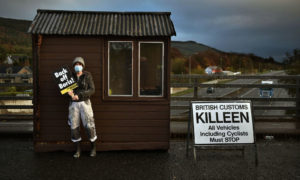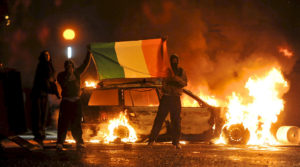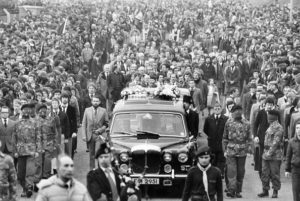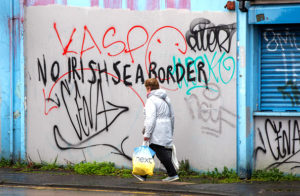It’s been exactly three years since the 29-year-old journalist Lyra McKee was killed in the Creggan area of Derry, hit by a stray bullet from the dissident “New IRA”. She was reporting from the scene of a riot, an event that the assembled press pack would have deemed unlikely to be life-threatening, although certainly edgy.
Books of condolence were opened in numerous cities. Politicians from all sides voiced their deep regret. It moved the world, to see this representative of an apparently post-Troubles Northern Ireland — a young, gay, working-class Catholic woman with many Protestant friends — cut down by something that had darted out of the shadows to re-assert what many outsiders assumed had disappeared from the political scene: the fanatical pursuit of a united Ireland by means of violence.
Lyra herself hadn’t been much of a cheerleader for either side of the border argument: she wrote in 2014, “I don’t want a united Ireland or a stronger Union. I just want a better life.” By 2019, in personal terms, life had indeed got much better since the days when she was a lonely, unhappy teenager, bullied for her emergent sexuality. She had a partner, a successful career as a journalist, and a two-book deal with Faber. Politically, however, Northern Ireland was in much worse shape than many might have hoped when the Belfast Agreement was signed in 1998 — something Lyra was acutely aware of. Her articles circled the dark psychological legacy of the Troubles, including the high suicide rate among the generation who grew up after the Agreement, many of them trapped in pockets of deprivation and neglect where violence still held sway.
In her last essay, published posthumously in the Guardian, Lyra skewered the bargain made for her generation, or at least how it had played out: “We were to reap the spoils and prosperity that supposedly came with peace. In the end, we did get the peace — or something close to it — and those who’d caused carnage in the decades before got the money. Whether they’d abandoned arms (as the Provisionals did) or retained them (like the Loyalists), they’d managed to make a ton of paper. We got to live with the outcome of their choices.”
The politicians had made three promises to sell the peace deal to the Northern Ireland electorate, she said. The first, peace itself, they “barely delivered on”: paramilitaries may have stopped murdering “the other side”, but they quickly began “terrorising their own” with renewed vigour in working-class communities, something that barely excited attention outside of Northern Ireland. The second promise was prosperity in a thriving new peacetime economy, one which failed to materialise for most younger people. The third failed pledge, she said, “was the one that hurt the most”, and was felt mostly in the areas where “the gunmen continued to roam”. The politicians had promised that “the days of young people disappearing and dying young were gone”. As everyone knows — not least Lyra’s own family — they weren’t.
Three years on, Lyra McKee’s analysis of the way in which her generation had been let down remains, sadly, accurate. Northern Ireland required a unified, determined and highly thoughtful approach to rebuilding a civil society: it never got one. The British government bolted unionists and nationalists together in the oddly-constructed power-sharing Stormont administration, and then retreated with great relief, intervening like a distracted parent only at moments of crisis and collapse.
The concessions granted to paramilitary organisations in order to broker the Agreement — such as the release of republican and loyalist prisoners from jail — were not seen as one-off gestures, after which authority would clamp down hard on paramilitary activity and its routine glorifications of a murderous culture. Instead these concessions became a template for a new, politically tentative approach to paramilitarism, which has uneasily endured for almost 25 years.
Its central tenet appeared to be that so long as the loyalist and republican paramilitaries avoided explicit acts of sectarian violence, and refrained from bombings and shootings outside Northern Ireland, they should not be overly antagonised at home: their working-class fiefdoms would effectively remain their own, “policed” by bullets and brutal beatings doled out to troublesome youths, or those who simply defied bullying.
A series of post-Agreement IRA murders of young Catholic men, from Andrew Kearney in 1998 to Paul Quinn in 2007, were politically overlooked. Sinn Fein politicians frequently commemorate what Deputy First Minister Michelle O’Neill calls “our freedom struggle” in terms which gloss over the squalid reality of IRA killings. Flags of the Ulster Volunteer Force — responsible for some of the most grotesque sectarian murders of the Troubles — have been put up sporadically in mixed Belfast housing estates, no doubt intended to intimidate Catholic residents. Despite the valiant efforts of many small-scale community projects aimed at building reconciliation, the self-laudatory nature of former and current paramilitary organisations has persistently worked against building an idea of Northern Ireland as a “shared” place.
Loyalist paramilitaries, the UDA and the UVF, are meanwhile securing their finances by means of extortion, intimidation and the drugs trade. And republican “dissident” groups such as the New IRA and the Continuity IRA are embroiled in criminal activity while also pledging to continue with their violent campaign for a united Ireland. It doesn’t seem as if the PSNI’s Northern Ireland Paramilitary Crime Task Force, set up in 2017, is going to be retired any time soon.
If the current paramilitary scene is a volatile mix, with a fair amount of money and arms sloshing around in it, the bad news is that the wider politics is far from steady either. Indeed, the strongest feature of Northern Irish politics since 1998 has been the steady erosion of its middle ground, with the more centrist unionist UUP and nationalist SDLP losing out to the DUP and Sinn Fein respectively. Sinn Fein, which includes many prominent former IRA members, is currently on course to be Northern Ireland’s largest party after the May 5 elections — as well as Ireland’s richest, its slick electoral machine oiled by nearly £4 million left to it in the will of an eccentric Englishman, William Hampton.
Ulster unionism has perhaps never, in living memory, felt itself so precarious. A long spell of devolution has eroded bonds with the — nominally — Conservative and Unionist party, leaving unionists with few other political allies in the UK. Nor have DUP politicians served their own cause well: narrowly focused on small gains, their reputation as canny political horse-traders has too often been undermined by an acceptance of limping nags tricked up for market-day. The most notable was an early acquiescence — later rescinded — to Boris Johnson’s Brexit plan involving a degree of “regulatory divergence” for Northern Ireland, sold by their Prime Minister with fervent assurances that a customs border in the Irish Sea would happen only “over my dead body”.
The customs sea border is now long established, under the Northern Ireland protocol, and Johnson is very much alive. Perhaps no other British Prime Minister would have been so reckless as to amputate one part of the UK from the rest and believe that the consequences would be negligible, but the deed has been done.
For the moment the political pain is largely experienced by unionism, and it is growing more intense, as are the arguments between the unionist parties over how best to oppose the sea border. There have been attempts to overturn the Protocol in the courts, but the most recent judgement by the Court of Appeal was that it “lawfully modified” the 1800 Acts of Union and could stand. A series of local rallies have been held to emphasise public anger against the legislation, but they have drawn little attention from London. Westminster had been sabre-rattling towards the EU about triggering Article 16 to suspend Northern Ireland customs checks — but with the British government preoccupied by Ukraine and its own rolling scandals, this rhetoric has grown notably quieter.
The loyalist paramilitaries — who, like their republican counterparts, view violence as the ultimate means of political conversation — are growing restless. Earlier Brexit proposals, involving some form of “frictionless” land customs border with the Republic of Ireland, were later shelved in no small part because the then Taoiseach Leo Varadkar energetically emphasised the risk of a return to republican violence if a customs border were put in place. The loyalists are now clearly beginning to wonder if their violence is deemed to be of inferior quality, and pondering how they might put that right.
In a grim echo of the IRA’s campaign in England during the Troubles, they have begun to speak of threatening politicians and targets in the Republic of Ireland. To emphasise the point, the UVF recently put on a disturbing theatrical display during a visit of the Irish Foreign Minister Simon Coveney to Belfast, by hijacking a van and using it to transport a hoax bomb to the event he was attending.
The wider unionist population has little time for such threats and theatrics, but it is nonetheless politically worried. A Sinn Fein First Minister in Stormont would be a symbolic defeat for unionism, especially when allied to the possibility of the party entering government in Dublin in 2025. The vision of an Ireland presided over by Sinn Fein leader Mary Lou McDonald — who has described the IRA campaign as “justified” — with the elder statesman Gerry Adams celebrating in the background, is one which horrifies even the most moderate of unionists.
It is far from a done deal, since older voters in Ireland remain wary, having a keener memory of IRA atrocities, and many in the other Irish parties are acutely conscious of the possible harm which a Sinn Fein government could do to a broadly successful state: in recent polls, Republican parties Fianna Fáil and Fine Gael regained a measure of electoral ground. Still, Sinn Fein success remains a distinct possibility: younger voters may be swayed by promises on health and housing, and the party’s bogus but strategic rewriting of the Provisional IRA campaign as necessary for “civil rights”.
The landscape in Ireland, North and South, is not what one would have hoped for in 1998, or even at the time of Lyra McKee’s death in 2019: an increasingly unmoored, isolated unionism, twitchy loyalist paramilitaries, a triumphalist Irish republicanism, and a democratic Irish electorate potentially sleepwalking towards installing a government organically linked to a long and bloody sectarian campaign.
And yet, in the thick of it all, the border is not the burning question for ordinary people in Northern Ireland that many might imagine: a recent poll found that only 30% would back the reunification of Ireland if a border poll were held tomorrow, with 45.3% voting against it. When they are asked what they want, Northern Ireland itself is a more settled entity than it often appears. Like any other voters, they are currently more preoccupied with the health service and the cost-of-living crisis; like Lyra, they “just want a better life”.
But Northern Ireland’s intensifying political situation now merits urgent attention from any British or Irish politicians who can co-operate to defuse it: chaos in Northern Ireland, after all, has almost never taken account of what ordinary people want.
Disclaimer
Some of the posts we share are controversial and we do not necessarily agree with them in the whole extend. Sometimes we agree with the content or part of it but we do not agree with the narration or language. Nevertheless we find them somehow interesting, valuable and/or informative or we share them, because we strongly believe in freedom of speech, free press and journalism. We strongly encourage you to have a critical approach to all the content, do your own research and analysis to build your own opinion.
We would be glad to have your feedback.
Source: UnHerd Read the original article here: https://unherd.com





